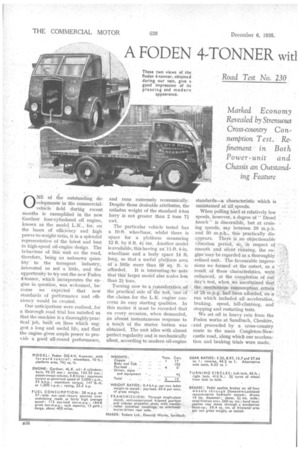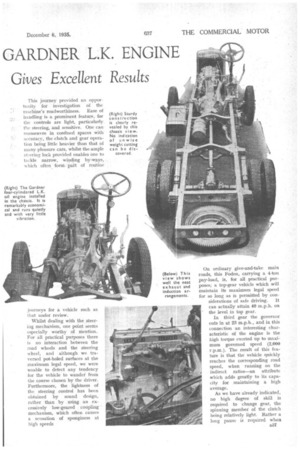A FODEN 4-TONNTR wit GARDNER L.K. ENGINE
Page 50

Page 51

Page 52

If you've noticed an error in this article please click here to report it so we can fix it.
Gives Excellent Results
ONE of the outstanding de-. velopments in the commercialvehicle field during recent months is exemplified in the new. Gardner four-cylindered oil engine,. known as the model L.K., for, on the bases of efficiency and high . power-to-weight ratio, it is a splendid representative of the latest and best in high-speed oil-engine design. The behaviour of this unit on the road, therefore, being an unknown quantity' to the transport industry, . interested us not a little, and the opportunity to try out-the new &den 4-tonner: which incorporates the engine in question, was welcomed, be , cause we expected that new standards of performance and effi
ciency would be created. .
Our anticipations were realized, for a thorough road trial has satisfied us that the machine is a thoroughly prac; tical -job, built . oii. lines which suggest a long and useful life, and that the engine gives ample power to provide a god& all-round performance,
and runs extremely economically. Despite these desirable attributes, the unladen weight of the standard 4-ton lorry is not greater than 2 tons 71 cwt.
The particular vehicle tested has a 10-ft. wheelbase, whilst there is space for a platform measuring 12 ff. by 6 ft. 44 ins. Another model is available, this having an '11-ft. 9-in. wheelbase and a body space 14 ft. long, so that a useful platform area of -a little more than S9 sq. ft. is afforded. It is interesting tonote that this larger model also scales less than 2 tons.
Turning now to a consideration of the practical side of the test, one of the claims. for the L.K. engine concerns its easy starting qualities. In this matter it must be recorded that on every occasion, when demanded, an almost, instantaneous response to a touch of the starter button was obtained, The unit idles with almost perfect regularity, and is mechanically silent, according to modern oil-engine standards—a characteristic which is maintained at all, speeds.
When pulling hard at relatively low speeds, however, a degree of " Diesel knock" is discernible, but at cruis• ing speeds, say between 20 m.p.h. and 30 m.p.h., this practically disappears. There is no objectionable vibration period, so, in respect of smooth and silent running, the engine May be regarded as a thoroughly refined unit.. The favourable impressions we formed at the outset, as a result of these characteristics, were enhanced, at the completion of our day's test when we ascertained that the meritorious consumption return of 28 m.p.g. had been afforded, on a run which included all acceleration, braking, speed, hill-climbing, and stopping and restarting tests.
We set off in heavy rain from the Foden works at Sandbach, Cheshire, sand proceeded by a cross-country route to the main Congleton-New; castle road, along which our acceleration and braking trials were made. This journey provided an opportunity for investigation of the machine's roadworthiness. Ease of handling is a prominent feature, for the controls are light, particularly the steering, and sensitive. One can manceuvre in confined spaces with accuracy, the clutch and gear operation being little heavier than that of many pleasure cars, whilst the ample steering lock provided enables One to tackle narrow, winding by-ways, which often form part of routine journeys for a vehicle such as that under review.
Whilst dealing with the steering mechanism, one point seems especially worthy of mention. For all practical purposes there is no interaction between the road wheels and the steering wheel, and although we traversed pot-holed surfaces at the maximum legal speed, we were unable to detect any tendency for the vehicle to wandet from the course chosen by the driver. Furthermore, the lightness of the steering control• has been obtained by sound design, rather than by using an excessively low-geared coupling mechanism, which often causes a sensation of sponginess at high speeds
On ordinary give-and-take main roads, this Foden„ carrying a 4-ton pay-load, is, for all practical purposes; a top-gear vehicle which will maintain its maximum legal speed for so long as is permitted by con
siderations of safe driving. It can actually attain 40 m.p.h. on the level in top gear.
In third gear the governor cuts in at 23 m.p.h., and in this connection an interesting characteristic of the engine is the high torque exerted up to maximum governed speed (2,000 r.p.m.). The result of this feature is that the vehicle quickly reaches the corresponding road speed, when running on the indirect ratios—an attribute which adds greatly to its capacity for maintaining a high average.
As we have already indicated, no high degree -of skill is required to change gear, the spinning member of the clutch being relatively light. Rather a long pause is required when effecting upward changes, but the pressure needed to operate the clutch is moderate, an.d the lever is easy to move. The indirect gears run silently.
For our hill-climbing test we used the initial section of the road leading out of Kidsgrove towards Biddulph. The gradient here is about half-a-mile long and starts off abruptly with an incline of about I. in 71, certain steeper sections being encountered at intervals before the summit of the hill is reached. Naturally we used first gear, but even on the steepest portion—about I in 6i— our speed was over 5 m.p.h.
Throughout the ascent the vehicle speed was controlled entirely by the • governor, showing that there was power in hand.
That the cooling arrangements are satisfactory is proved by the fact that, at the conclusion of the halfmile climb, the temperature of the water in the radiator was well below boiling point.
The operation of stopping and restarting presents no difficulty, for either the hand or the foot brake will securely hold the fully laden vehicle on a gradient as steep as I in 61, whilst the clutch takes up the drive smoothly, The layout of the braking system is carried out on more or less conventional lines. A Lockheed hydraulic system is coupled to a De wandre servo motor, the master
valve of which communicates with a vacuum tank. There is an enginedriven exhauster and a vacuum gauge on the facia-board. Under normal operating conditions the pedal pressure required to bring the vehicle to
rest is little heavier than that needed to withdraw the clutch, whilst even for an emergency stop only a moderate effort is demanded.
The adjustment of the hand brake is noteworthy. for its simplicity. To
shorten the effective length of the rod from the lever to the rear brake cross-shaft it is necessary merely to
screw up one self-locking nut, which u38
is readily accessible from the ground.
Although the suspension system does not incorporate external damping devices, the vehicle is stable at high speeds. Very little reciprocal action between the front and rear springs can be detected, whilst, when bends and corners are taken fast, rolling is practically nonexistent and the vehicle evinces no tendency towards "yawing." On all counts the Foden. 4-tonner must be considered an eminently safe and serviceable vehicle, robustly built, and incorporating first-rate materials. Its extraordinarily good fuel consumption lends it an attraction that can hardly be overestimated. Compared with figures obtained during tests of similar oilers of earlier design, the return afforded on this occasion does definitely set our anticipated new standard.
At the moment the production department of Fodens, Ltd., is en gaged in a revision of manufacturing costs, accordingly we are unable to state the price of the 4-tonner.




























































































